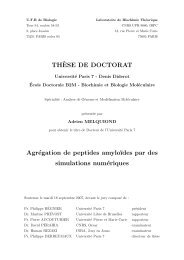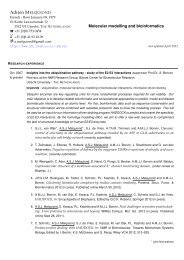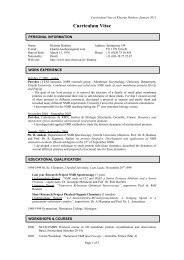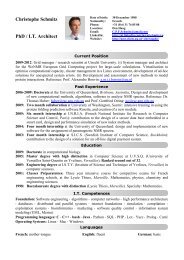Thesis Title: Subtitle - NMR Spectroscopy Research Group
Thesis Title: Subtitle - NMR Spectroscopy Research Group
Thesis Title: Subtitle - NMR Spectroscopy Research Group
Create successful ePaper yourself
Turn your PDF publications into a flip-book with our unique Google optimized e-Paper software.
34 Chapter 2. Possum: paramagnetically orchestrated spectral solver of unassigned methyls.<br />
(2.3)<br />
(2.4)<br />
where PCS S calc(k,l) is the predicted PCS value for the spin S (S = 13 C or 1 H) of the methyl<br />
group in residue k arising from the paramagnetism of the lanthanide l, para δ S exp(j,l) is the chemical<br />
shift of the resonance j in the presence of the lanthanide l for the spin S, and dia δ S exp(i) is the<br />
diamagnetic resonance i for the spin S. The cost function assigns smaller costs for deviations<br />
between calculated and observed PCS when the experimentally observed PCS is large, while the<br />
constant e(l) prevents a singularity in the cost function and accounts for the error in measurements<br />
when a spin experiences small paramagnetic effects far away from the paramagnetic center. e(l)<br />
scales with the magnitude of the tensor of the lanthanide l. Empirically determined values<br />
(e(Yb 3+ ) = 1/6 ppm and e(Dy 3+ ) = 1 ppm) were used here 2 . Equations (2.3) and (2.4) ensure that<br />
each calculated PCS and each experimental chemical shift are chosen exactly once within the<br />
global assignment.<br />
Equations (1.1), (2.3) and (2.4) present the formulation of the three-index assignment<br />
problem (Schell, 1955) which is the three-dimensional instance of the multidimensional assignment<br />
problem (MAP). With D being the number of dimensions of the MAP (D = 3 in the example above)<br />
and n being the size of each of the D sets of data, there are (n!) D-1 possible assignments. When D is<br />
strictly larger than 2, MAP has been proven to be NP-hard (Karp, 1972) and, as a result, no<br />
algorithm can guarantee the best solution to the problem in a polynomial time. An exhaustive<br />
2 The purpose of e(l) is to avoid degenerate cases where the experimental PCS is very close to zero.<br />
Its value is not critical for the success of the algorithm. E(l) has however been optimized to yield<br />
best possible results.








